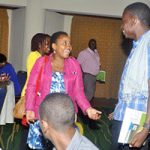HC3 University Initiative Webinar “How to Get Published—A Conversation with Journal Editors”
![]() During a university needs assessment in 2014, the Health Communication Capacity Collaborative (HC3) identified some of the greatest challenges universities in sub-Saharan Africa and Asia face, including limited access to current literature, limited opportunities for scholarly publication and limited opportunities to participate in local, regional and international scholarly networks.
During a university needs assessment in 2014, the Health Communication Capacity Collaborative (HC3) identified some of the greatest challenges universities in sub-Saharan Africa and Asia face, including limited access to current literature, limited opportunities for scholarly publication and limited opportunities to participate in local, regional and international scholarly networks.
To provide advice on how to improve the ability of faculty and students in Africa and Asia to generate publishable research manuscripts, the HC3 University Initiative’s third webinar was on the topic, “How to Get Published—A Conversation with Journal Editors.” Participating editors from five peer-reviewed journals shared brief descriptions of their journals, answered questions on the types of manuscripts of interest to their readers and the nature of the review process, and provided suggestions for authors that might encourage or facilitate more quality manuscript submissions.
Presenters included Scott Ratzan, MD, editor-in-chief, Journal of Health Communication: International Perspectives; Natalie Culbertson, managing editor, Global Health: Science and Practice (GHSP) Journal; S. Shyam Sundar, PhD, editor-in-chief, Journal of Computer-Mediated Communication; Winston Mano, PhD, principal editor, Journal of African Media Studies; and Silvio Waisbord, PhD, editor-in-chief, Journal of Communication.
Some tips for aspiring journal authors that the editors shared during the webinar included –
- Focusing the scope of research to increase the likelihood of getting published in high-impact factor journals. USAID and UNICEF developed a Journal of Health Communication supplement as an outcome of an Evidence Summit on Child Survival and Behavior Change that included articles from authors focused on gathering research and data from social and behavior change communication theory and practice around child survival.
- Developing a strong abstract outlining research findings or programs and sample size is more important than things like perfect grammar. Generally, the Global Health: Science and Practice (GHSP) Journal rejects articles with a small sample size, not enough detail on how a program is implemented or that cover programs that are not replicable or sustainable.
- To maximize the likelihood of selection, authors should focus on submitting articles with a clearly defined target audience to reach with their article or research findings. At the Journal of Communication, reviewers are asked to assess the merit of an article based on its contribution to communication theory and its focus on answering a practical policy question.
- Desk rejections at the Journal of Computer-Mediated Communication (JCMC) often happen because authors go beyond the scope of the journal and don’t deal with technology directly. An article on an mhealth program is not sufficient. Authors should focus on the unique quality that technology played in enhancing communication. Article acceptance at JCMC is based on applicability to others, as well as theory.
- At the Journal of African Media Studies, they try to help authors that are not native English speakers if they feel their article sufficiently focuses on building empirical evidence.
Click here for more resources and to watch the recorded webinar.







Leave a Reply
Want to join the discussion?Feel free to contribute!